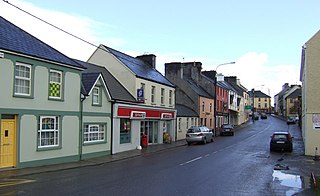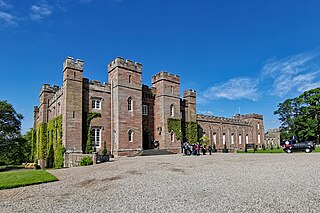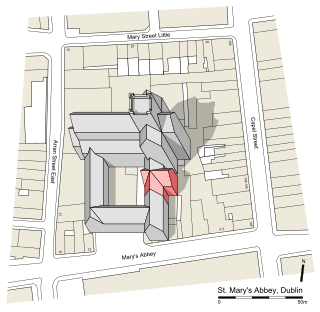
County Longford is a county in Ireland. It is in the province of Leinster. It is named after the town of Longford. Longford County Council is the local authority for the county. The population of the county was 46,634 at the 2022 census. The county is based on the historic Gaelic territory of Annaly (Anghaile), formerly known as Teffia (Teathbha).

The Kingdom of Desmond was a historic kingdom in southwestern Ireland. It was founded in 1118 by Tadhg Mac Cárthaigh, King of Munster when the Treaty of Glanmire formally divided the Kingdom of Munster into Desmond and Thomond. It comprised all of what is now County Cork and most of County Kerry. Desmond was ruled by the Mac Cárthaigh (MacCarthy) dynasty. Other clans within the kingdom included the O'Sullivans and O'Donovans. Following the Norman invasion of Ireland in the late 12th century, the eastern half of Desmond was conquered by the Anglo-Normans and became the Earldom of Desmond, ruled by the Fitzmaurices and FitzGeralds—the famous Irish family known as the Geraldines. The king of Desmond, Diarmaid Mac Cárthaigh submitted to Henry II of England, but the western half of Desmond lived on as a semi-independent Gaelic kingdom. It was often at war with the Anglo-Normans. Fínghin Mac Carthaigh's victory over the Anglo-Normans at the Battle of Callann (1261) helped preserve Desmond's independence. The kings of Desmond founded sites such as Blarney Castle, Ballycarbery Castle, Muckross Abbey and Kilcrea Friary. Following the Nine Years' War of the 1590s, Desmond became part of the Kingdom of Ireland.

Muckross Abbey is one of the major ecclesiastical sites, found in the Killarney National Park, County Kerry, Ireland. It was founded in 1448 as a Franciscan friary for the Observantine Franciscans by Donal McCarthy Mor.

Milltown is a small town on the N70 national secondary road between the major towns of Tralee and Killarney in County Kerry, Ireland. It is approximately 7 kilometres (4 mi) from Killorglin.

Colmán of Cloyne, also Colmán mac Léníne, was a monk, founder and patron of Cluain Uama, now Cloyne, County Cork, Ireland, and one of the earliest known Irish poets to write in the vernacular.

Dunkerron Castle is a ruined four-storey tower house located in Templenoe, near Kenmare, County Kerry, in south-west Ireland. The castle was the family seat of the O'Sullivan Mór family from the late 16th century.

Scone is a town in Perth and Kinross, Scotland. The medieval town of Scone, which grew up around the monastery and royal residence, was abandoned in the early 19th century when the residents were removed and a new palace was built on the site by the Earl of Mansfield. Hence the modern village of Scone, and the medieval village of Old Scone, can often be distinguished.

St. Mary's Abbey was a former Cistercian abbey located near the junction of Abbey Street and Capel Street in Dublin, Ireland. Its territory stretched from the district known as Oxmanstown down along the River Liffey until it met the sea. It also owned large estates in other parts of Ireland. It was one of several liberties that existed in Dublin since the arrival of the Anglo-Normans in the 12th century, which gave it jurisdiction over its lands.

The Spring family is a Suffolk gentry family that has been involved in the politics and economy of East Anglia since the 15th century, as well as holding large estates in Ireland from the 16th century.
The Godfrey Baronetcy of Bushfield in the County of Kerry was a title in the Baronetage of Ireland. It was created on 17 June 1785 for William Godfrey, member of the Irish House of Commons for Tralee. The title became extinct on the death of the seventh Baronet in 1971.

The Cistercian Abbey of Woney, also written Wotheny or Owney, on the banks of the Mulkear River in Abington, County Limerick, was founded in 1205 when Theobald Walter, brother of Hubert Walter, granted the whole "theodum" of Woodenikuwice for the purpose. Traces of the architecture and layout of the monastery may still seen in the graveyard in the hamlet of Abington, just south of Murroe.
Walter Spring the Unfortunate was an Anglo-Irish Roman Catholic landowner involved in the Irish Confederate Wars.
Sir William Duncan Godfrey, 3rd Baronet (1797–1873) was an Anglo-Irish aristocrat and landowner.
Sir William Godfrey, 1st Baronet (1739–1817) was an Anglo-Irish member of the Irish House of Commons.
Thomas Spring of Castlemaine was an English Protestant soldier, politician and Constable of Castle Maine in County Kerry, Ireland.
Tybroughney, statutory spelling Tibberaghny, is a civil parish in the barony of Iverk, County Kilkenny in Ireland. The parish comprises a single townland, also called Tibberaghny. It lies on the north bank of the River Suir facing County Waterford, while the Lingaun river separates it from County Tipperary to the west.

St. Francis Abbey, also called Kilkenny Grey Friary, is a medieval Franciscan abbey and National Monument located in Kilkenny City, Ireland.

The Monastery of Ennisnag was an early Irish Christian monastery, and later a medieval prebendal church, located at Ennisnag, in County Kilkenny, Ireland. The medieval monastery and church are no longer extant. From the ruins, St Peter's church, of Protestant denomination, was established in the early 19th century.
Garfinny Church is a medieval church and National Monument in County Kerry, Ireland.

Castle Maine, also recorded as Castle Magne and Castlemaine, was a medieval castle located at what is now Castlemaine, County Kerry. The castle, built in 1215, stood on a bridge over the River Maine. A defensive structure of considerable importance in Munster, it belonged first to the Earls of Desmond and later to the English Crown. Castle Maine was besieged on several occasions, including during the Nine Years' War when the garrison resisted for thirteen months. It was destroyed in 1652 during the Cromwellian conquest of Ireland.















